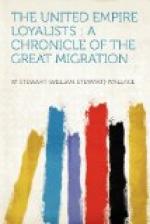The houses, which had been originally built of wood, had severally disappeared. Some had been taken to pieces and removed to Halifax or St John; others had been converted into fuel, and the rest had fallen a prey to neglect and decomposition. The chimneys stood up erect, and marked the spot around which the social circle had assembled; and the blackened fireplaces, ranged one above another, bespoke the size of the tenement and the means of its owner. In some places they had sunk with the edifice, leaving a heap of ruins, while not a few were inclining to their fall, and awaiting the first storm to repose again in the dust that now covered those who had constructed them. Hundreds of cellars with their stone walls and granite partitions were everywhere to be seen like uncovered monuments of the dead. Time and decay had done their work. All that was perishable had perished, and those numerous vaults spoke of a generation that had passed away for ever, and without the aid of an inscription, told a tale of sorrow and of sadness that overpowered the heart.
Alas for the dreams of the Pynchons and the Parrs! Shelburne is now a quaint and picturesque town; but it is not the city which its projectors planned.
CHAPTER VII
THE BIRTH OF NEW BRUNSWICK
When Governor Parr wrote to Sir Guy Carleton, commending in such warm terms the advantages of Shelburne, he took occasion at the same time to disparage the country about the river St John. ‘I greatly fear,’ he wrote, ’the soil and fertility of that part of this province is overrated by people who have explored it partially. I wish it may turn out otherwise, but have my fears that there is scarce good land enough for them already sent there.’
How Governor Parr came to make so egregious a mistake with regard to the comparative merits of the Shelburne districts and those of the St John river it is difficult to understand. Edward Winslow frankly accused him of jealousy of the St John settlements. Possibly he was only too well aware of the inadequacy of the preparations made to receive the Loyalists at the mouth of the St John, and wished to divert the stream of immigration elsewhere. At any rate his opinion was in direct conflict with the unanimous testimony of the agents sent to report on the land. Botsford, Cummings, and Hauser had reported: ’The St John is a fine river, equal in magnitude to the Connecticut or Hudson. At the mouth of the river is a fine harbour, accessible at all seasons of the year—never frozen or obstructed by ice... There are many settlers along the river upon the interval land, who get their living easily. The interval lies on the river, and is a most fertile soil, annually matured by the overflowing of the river, and produces crops of all kinds with little labour, and vegetables in the greatest perfection, parsnips of great length etc.’ Later Lieutenant-Colonel Isaac Allen and Edward Winslow, the muster-master-general of the provincial forces, were sent up as agents for the Loyalist regiments in New York, and they explored the river for one hundred and twenty miles above its mouth. ‘We have returned,’ wrote Winslow after his trip, ’delighted beyond expression.’




